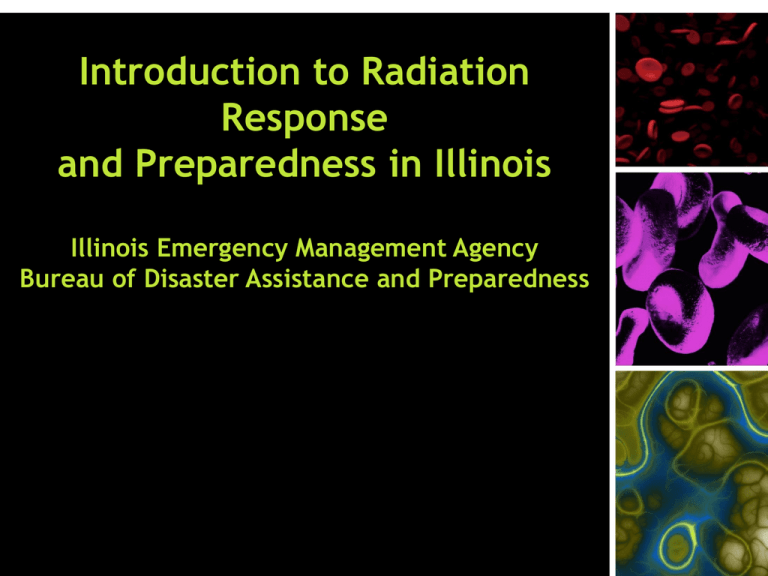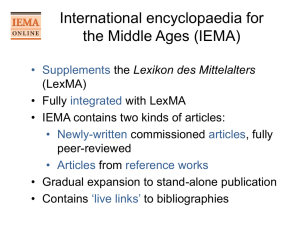Introduction to Radiation Response & Preparedness
advertisement

Introduction to Radiation Response and Preparedness in Illinois Illinois Emergency Management Agency Bureau of Disaster Assistance and Preparedness Basics to Illinois Preparedness • Where is Illinois in the Nuclear/Radioactive Material Business? • Who’s is in charge? • How does Illinois Prepare? • What exactly does the state do? • Contaminated patients • Contamination Control • Resources available Nuclear Illinois • Illinois has 6 operating plants • 11 reactors • Spent storage facilities • Argonne National Lab • Major shipping corridors • 750 Radioactive Material Licensees •20,000 radiation producing machines Nuclear Illinois In Comparison Who is in Charge??? • Exelon is owner/operator of Illinois’ reactors • Nuclear Regulatory Commission (NRC) oversees Exelon • Federal Emergency Management (FEMA) oversees planning and safety outside the fence • Illinois Emergency Management Agency (IEMA) implements Illinois Plan for Radiological Accidents (IPRA) Preparedness is addressed through IPRA • IPRA Establishes a state-wide policy for responders • IPRA outlines responsibilities for: • State • County • Municipal Jurisdictions Responsibilities • Each agency has specific roles outlined in the IPRA plan – – – – ISP security and traffic access and control IDNR secures waterways and state parks IDPH notifies POD hospitals IEMA coordinating agency • Division of Nuclear Safety is the response/scientific arm IEMA • Monitors plants • • Remotely • Gamma Det. Network (GDN), Reactor Data Link (RDL), Gaseous Emission Monitoring System (GEMS) Directly • On-site via Resident Inspectors • Quarterly environmental samples • Extensive Training Program • State • County • Municipal Ensuring Preparedness • Plans are developed around 16 planning standards • Plans are exercised every 2 years • Last 2 years IEMA has averaged 4,000 + participants each year 2011 Activities • • • • • • • Dresden 3/23/11 Partial Quad Cities 4/20/11 Utility LaSalle 5/18/11 Utility Byron 7/27/11 Partial Braidwood 9/14/11 Utility Zion 11/2/11 Defueled Clinton 11/30/11 Full State Incident Response Center (SIRC) Radiological Emergency Assessment Center (REAC) Unified Area Command Radiological Assessment Field Team (RAFT) RAFT Capabilities • Field Teams Collect • Air, water, grass, soil and foods (corn and garden plants) • Mobile Laboratory • Prepares and analyzes samples • Isotopes • Radiation Levels • IDOT Helicopter is equipped with detection equipment • Maps plume outline and levels Radiation Incidents Radiation incidents can be caused by human error or intentional acts: • Transportation • Power plant (members of the public only) • Radiological Dispersal Device (RDD) • Improvised Nuclear Device (IND) Injured Contaminated Public • Radioactive Materials are considered hazardous • Contamination is often considered more “nuisance” HOWEVER • Injury takes precedence over contamination • Stabilize patient first Contamination vs Exposure • Exposed patients pose no contamination issue • Contaminated patients can pose both – Contamination issues – Potential inhalation/ingestion hazard (airborne particulate) Protect Yourself • Universal Precautions – Gown, face shield, bouffant, booties and DOUBLE GLOVES • Control contamination by – – – – Changing gloves frequently Minimize access to treatment area Utilizing Nuclear Medicine Staff for monitoring Bag patients hands and remove clothing Decontamination • • Removing clothing can reduce contamination by 80-90% – Clothing should be double bagged and stored in designated area • Minimize use of water so contamination does not spread – Baby wipes – Saline and 4x4 pads – Use towels etc. to absorb any runoff Considerations • Upon notification of a contaminated/potentially contaminated patient – Notify additional staff • Nuclear Medicine • Maintenance • Emergency Department Staff • Contaminated patients are personnel intensive Resources Available • IEMA – Radiological Duty Officer – – – – Contamination control measures Decontamination methods Dispatch additional staff Monitoring and radiation levels • REAC/TS – Radiation Emergency Assessment Center/Training Site – – – – Recommend chelating agents Contaminated wounds Contaminated samples Internal dose assessments Want more information? • Visit our website!!!! • IEMA http://iema.illinois.gov/iema/ • RTF http://iema.illinois.gov/radiation/pdf/B NFS_RTFBrochure.pdf • REAC http://iema.illinois.gov/radiation/pdf/B NFS_REACBrochure.pdf Resources Radiation Emergency Assistance Center/ Training Site (REAC/TS) (865) 576-1005 • www.orau.gov/reacts/ Medical Radiobiology Advisory Team (MRAT) Armed Forces Radiobiology Research Institute (AFRRI) (301) 295-0530 • www.afrri.usuhs.mil Websites: www.acr.org - Disaster Preparedness for Radiology Professionals www.afrri.usuhs.mil - Medical Management of Radiological Casualties Handbook; Jarrett, 2003, and Terrorism with Ionizing Radiation Pocket Guide








